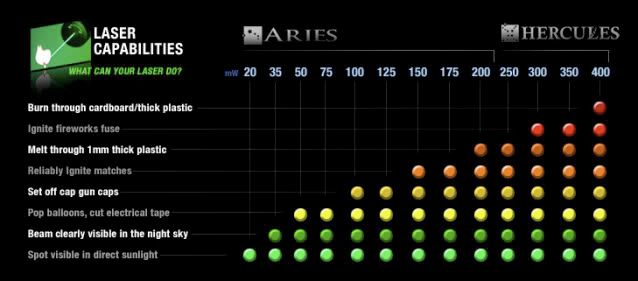Power is power.
100mW is 100mW regardless of wavelength.
Your only MAJOR variable is the material itself that the laser is being applied to. Blu-ray seems like it burns very well because it is readily absorbed by many different materials, including white paper.
Another variable, which is pretty minor in my opinion (because while blu-ray CAN focus slightly tighter than 650, the spot size we're talking about at this point is so minimal regardless of wavelength, that I dont think it makes a huge difference) is how small the spot itself will focus. 100mW focused into a 1mm spot has more energy density than 100mW focused into a 2mm spot.
Correct, power is power. But the differing wavelengths between two beams makes for a difference in the amount of "work" that the power can do.
"Now, not all photons are created equal. The shorter the wavelength the more energy the photon has. Hence a single photon at 405nm is much more energetic than a single photon at 1064nm. You can calculate this using the Planck's relationship E=hv. E=energy, h=6.626E-34 J-s, v is the frequency of the photon calculated from the inverse wavelength relationship v=c/gamma. c=speed of light, gamma = wavelength.
Ok for 405nm. v=300,000km/s / 405nm = 7.407E14 Hz
E = 6.626E-34 J-s * 7.704E14 cycles/s = 4.908E-19 J per photon of 405nm
for 1064nm v=300,000km/s / 1064nm = 2.820E14 Hz
E = 6.626E-34 J-s * 2.820E14 cycles/s = 1.868E-19 J per photon of 1064nm"
-Frothychimp
100mw of 405nm does more "work" than 100mw of 1064nm.
there's more math behind this that I've been looking up, I might be onto something. Plank's relationship incorporates wavelength into the work calculation, which is what we need.
The main obstacle at this point, is not finding the amount of work that a beam is capable of, its determining the absorption spectrum of the particular material we deal with. I say though, that the theoretical capabilities of a beam are what I would be interested in. If we had a theoretical material with a blacked- out absorption spectra, then we could then assume that every beam applied to that material, would then apply all of it's work potential to that surface. Then we could say that this laser, burns better than that other laser, taking both power and wavelength into account.
So technically, we could ditch the whole electrical tape deal, and just work with the numbers, let the math take over. In Frothy's calculation above, we can see just how many more Joules of work one wavelength is over another. This factor can be applied to, and combined with the power output of a laser, to get a particular beam's ability to do work. The unit we can use, is Joules.
Frothy mentioned to me that not necessarily the dot size but the energy density of the beam would have to have standardized. Fortunately, it can be accounted for by standardizing the W/cm^2. So if different dot sizes are used to measure the energy density, proportions can be used compensate for them.
So basically we CAN use math to compare laser beams so as long as we know the laser's wavelength and power output. I'll be doing some more research and try doing some more for real calculations to see what I can come up with. We can thank Frothy for the mathematical assistance.
some thoughts...




